8 Popular Social Media Sites and Platforms for Your Brand (2024)
According to DataReportal, 58.4% of the global population (more than 4.62 billion) people are active social media users. Because social media is such a popular way to stay connected nowadays, just about every business can benefit from having a social media presence. Whether you run a pest control business in California or a retail store in New York, your audience is already hanging out on social media.
And even though you might offer the highest-quality products or services, if you don’t put yourself in front of your audience where they’re hanging out, your competitors will always be multiple steps ahead of you.
Social media marketing has been a game-changer for many local businesses—it’s one of the most popular local marketing strategies. And if you want to build a rock-solid brand online, we’d strongly advise you to tap into the power of social media marketing.
3 Incredible Benefits of Social Media for a Local Business
We’ve put together this blog post to help you better understand why social media is one of the most popular local marketing strategies and how you can harness its power for your own business. Let’s dive in.
1. Helps build long-lasting relationships with local customers
Let’s say you run an Indian restaurant based in Los Angeles. You have a visually appealing and highly functional restaurant website. Your Google Business Profile listing ranks #1 in Google 3-Pack. You attract thousands of people to your website each week.
If the above is true, then you’re likely already attracting lots of diners to your restaurant.
But…even if that’s the case, you can still benefit from building a presence on social media. While you may already be seeing foot traffic to your restaurant thanks to your search engine optimization efforts, social media can help you build long-lasting relationships with your customers so that they keep coming back for more.
When you kickstart your social media efforts, not only will you be publishing high-quality social media posts that show off your delicious food and stellar customer service, but you’ll also be showing the human side of your business.
When done right, social media marketing can help your customers feel less like customers and more like friends. You can give them a peek behind the scenes, which will help them feel more connected to the people side of your business. And if they feel comfortable interacting with you on social media and love your content, they’ll be all the more likely to visit your restaurant again and again.
And this doesn’t just apply to restaurants. No matter what you offer, building long-lasting relationships with people in your local community should be your top priority. And that’s what social media marketing can help you with.
2. Helps position your business as trustworthy
Over 86% of people use Google or other search engines to look up local businesses. Let’s say you run a clothing store in Manhattan. If one of your potential customers is looking for a clothing store, what they’ll do is head over to Google and type in something like:
“best clothing stores near me,” or “best clothing stores in lower manhattan” or something similar.
And even if you’ve knocked your search engine optimization efforts out of the park and are ranking at the top of Google 3-Pack, they’ll probably want to know more about your business before they head over to your physical store or purchase from you online. So from that initial Google search, what they’ll probably do is head over to your website and visit your business’s social media profiles.
But wait—what if you haven’t created any social profiles?
If your potential customers can’t find your social media accounts, it could leave them with a bad first impression of your business. They’ll find it hard to trust your business.
Another alternative: If you created your business’s social media profiles a few months or years back and if they are unoptimized, irrelevant, or full of clutter, then you’d be presenting a really bad version of your business to your target audience.
Nowadays, having active accounts on relevant social media platforms is the bare minimum—people expect it. From optimizing your profiles to publishing high-quality content, focusing on your social media efforts will help you position yourself as credible and trustworthy.
3. Helps increase revenue
As we mentioned before, when you focus on your social media efforts, you’ll be positioning yourself as credible and trustworthy. This will help you make your potential customers feel comfortable—and customers that trust you and feel comfortable with you are more likely to purchase from you.
Furthermore, by building trust and focusing on long-lasting relationships, you’re creating loyal customers who will be more likely to spread the word about your business. They may spread the word by leaving you a review, telling their family members about your business, or sharing your social content with their friends and followers.
And as more and more people hear about and engage with your business, you’ll see an increase in sales and revenue.
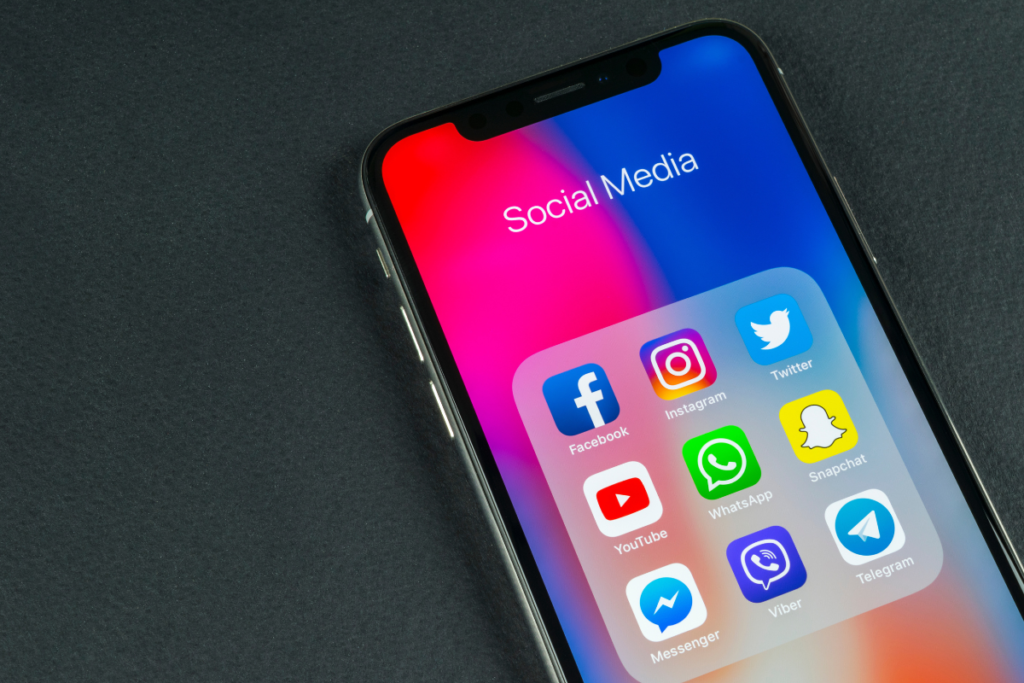
How to Create a Winning Social Media Marketing Plan
So, you know that social media marketing is one of the most powerful local marketing strategies. But you may be wondering…how do I get started? You’ll only be able to achieve the desired results if you build and implement a fool-proof social media strategy.
And that’s what we’ll be looking at now.
Choose the right platform(s)
If your audience is hanging out on Twitter but you’re laser-focusing your efforts on Instagram, you’re wasting time and money.
Randomly choosing platforms just because others are using them is something that we strongly advise against. If you want your social media efforts to deliver great results, the first step is to understand who your target audience is and where they hang out the most.
To do this, you’ll need to conduct thorough market and local audience research. We’d also advise you to dive deep into your competitors’ social media marketing strategies. This will help you understand which platforms are working well for your competitors.
You’ll also want to get an understanding of what other people in your industry are seeing in terms of engagement. Follower count is important, but it’s certainly not everything. Businesses with 200 followers might see a better ROI from social media than businesses with 2000 followers—it’s all about your strategy and your engagement rate.
Still not sure where to get started? We’ve put together the following charts to help you understand the pros and cons of 3 of the most popular social media platforms.
1. Google Business Profile
Google is how people find your business, full stop. Having a Google Business Profile that is up-to-date, descriptive, and visually compelling is key. When someone in your area searches for a local service, such as “plumbers in Modesto, CA,” Google quickly weighs all of the information it knows about those search terms and populates a curated list of businesses meeting those requirements on the customer’s screen.
While we could go on and on, we’ve already got you covered. Check out our complete guide to building a Google Business Profile you can be proud of here.
2. Facebook
Every small business should have a presence on Facebook. Because this platform has billions of monthly active users, it’s a great—and free—tool that can help you increase your brand awareness. The downside is that organic reach on this platform can be limited as Facebook tends to favor paid advertisements over organic posts.

3. Twitter
Twitter may have fewer monthly active users, but it can still be a powerful tool that helps businesses start important conversations and form deeper connections with their target audiences. The downside of Twitter is that it’s a very time-sensitive platform which can make it hard to keep up with. Twitter also limits the number of characters you can use per tweet, so you have to be more intentional about your posts.
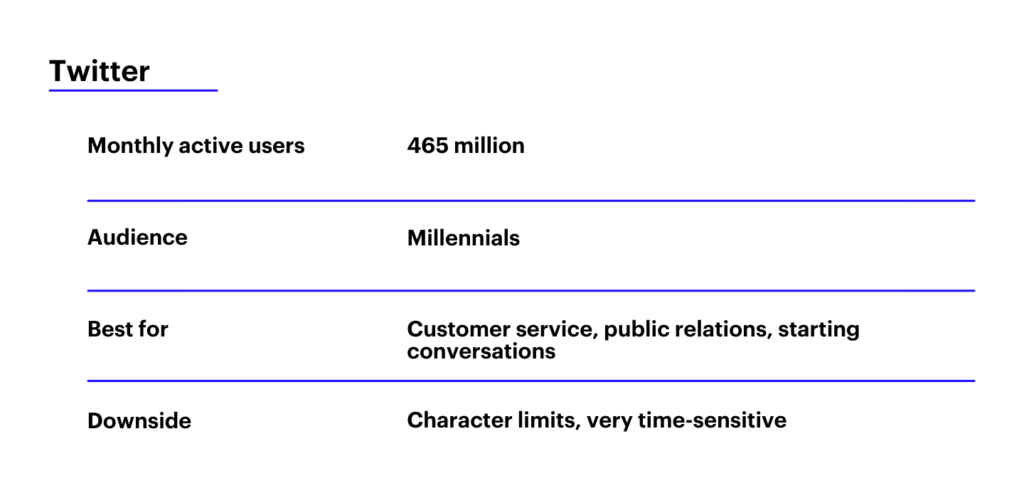
4. Instagram
With over 1.4 billion monthly active users, Instagram is a great platform where businesses can advertise, sell, and strengthen relationships with their customers. The downside of Instagram is that it’s very content-heavy. If you don’t have a dedicated content team, it might be hard to post engagement-worthy content on a consistent basis.
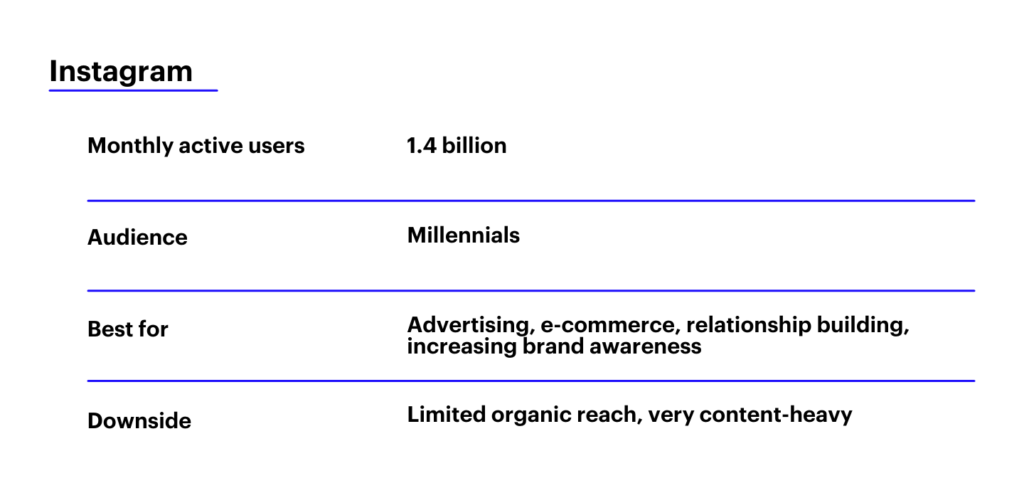
Outside of these big three channels, there are a number of other great social platforms your business should look into:
5. LinkedIn
Whereas Twitter, Facebook, and Instagram are social tools for both businesses and end consumers, LinkedIn is uniquely focused on business relationships.
Today, there are over 700 million LinkedIn users. You can use LinkedIn to find new employees, drive new audiences to your brand, and create community groups unique to your brand’s value proposition. You can also run campaigns targeted to specific titles, making it easy to attract the right customers to your business.
If you are a small B2B business, being active on LinkedIn is a no-brainer. But even B2C companies can benefit from building strong company profiles and personal brands on the platform. Here’s how you can put your best virtual foot forward on LinkedIn:
- Build a strong profile: Create a company profile for your small business (there’s literally an option to show you are a small business when building your profile). Make sure to provide as much information as possible and direct links to your website, and keep the following in mind…
- Use keywords in your company description. This is important as LinkedIn company pages are indexed by Google. Provide context to your mission, values, and products/services (around 3 paragraphs max).
- Add a branded cover image so you stand out from the crowd.
- Follow certain hashtags relevant to your business so you can respond quickly to content your audience cares about.
- Post and optimize: Post at a reasonable cadence and continue optimizing and experimenting. A few suggestions…
- Always include an image
- Keep copy short and don’t be afraid to call out your audience and pose questions
- Tag relevant people or partners to extend your reach
- Have a clear CTA so you don’t leave people guessing
- Respond to comments quickly to drive even more engagement
- Measure your success: Use LinkedIn’s built-in analytics to iterate and improve your posts based on audience engagement.
6. YouTube
There are 2 billion users today on YouTube, and for good reason: Video has become a great community-building tool over the last few years. If you have the resources to create videos, YouTube is a great free platform to:
- Highlight your company’s values, products, and services
- Grow your organic reach via SEO (it’s like having another website!)
- Share customer testimonials
- Offer employee and product training videos to your internal team
Similar to all other platforms, you’ll want to monitor comments and reply regularly to boost visibility on the platform. Here are a few suggestions to help you make the most of your YouTube channel:
- Encourage people to subscribe: SMASH THAT SUBSCRIBE BUTTON. Oh geez, sorry, not sure what came over us just then. But now that we have your attention, encouraging viewers to subscribe if they’re enjoying your content is a good idea for building your audience base.
- Use relevant keywords in copy: In your titles, descriptions, and tags make sure to use relevant and popular keywords so your content is easier to find and indexed appropriately by Google.
- Engage with like-minded content: It’s not always about you. It’s about the community you build. There are a lot of great content creators out there. Reaching out to influencers and channels that have overlapping audiences with your own will help you create valuable partnerships and extend your reach.
- Create curated playlists: If you’re producing a lot of content, particularly around different topics (for example product videos vs. customer testimonials), it’s a good idea to get organized. Using YouTube’s playlist feature will make it easier for audiences to find what they want on your channel page.
- Share videos on other platforms: YouTube is a community all its own, but also a good location to link back and share to across other platforms. For example, you could use snippets of video content to promote on Facebook, and then link back to the full video on your YouTube channel!
- Post regularly: We’re going to drill this in everywhere we can—consistency is vital on any social platform. If a viewer subscribes, they’re going to want to know you’ll be sharing more relevant content in the future. Don’t let them down, or they might not be subscribers for long.
7. Pinterest
Pinterest is an image-sharing platform which means for retailers, automotive, and home services, it can be a real game-changer. According to Pinterest, 80% of weekly “pinners” find a new brand or product via the platform. This is especially true for those starting creative projects.

To ensure you’re reaching people with engaging imagery and content, here are a few things to keep in mind:
- Build a compelling brand board: Your board is like a product showcase—just in the digital world. Since 97% of Pinterest searches are unbranded, having a compelling board with well-documented topics will help you reach new audiences. For example, Lululemon attracts people with an active lifestyle. As such, they compile topics on their board relevant to runners and those interested in athleisure wear.
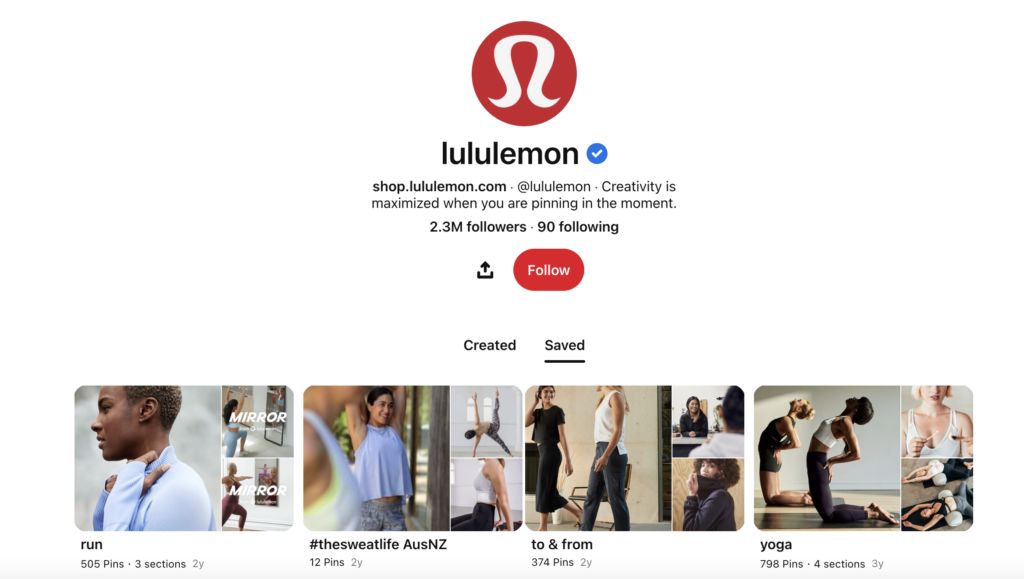
- Mix up your format: From video to carousel ads, there are many different ways to capture people’s attention with compelling visual storytelling! Just remember that many folks are viewing your content on mobile devices, so try and keep a 2:3 aspect ratio to avoid weird cropping debacles.
- Copy is still key: Having a hard-hitting description is going to drive even more conversions from your Pinterest content and help your SEO ranking. So choose your words wisely!
8. TikTok
TikTok is one of the fastest-growing social platforms out there. Using short-form videos and clever hooks, a whole new generation of content creators has found their home. And the best part? The barrier to entry is low. Small businesses on any budget can get creative and make an impact. By creating a business profile you can:
- Access performance metrics
- Gather audience insights
- Use creative tools that empower you to test, iterate and build a community
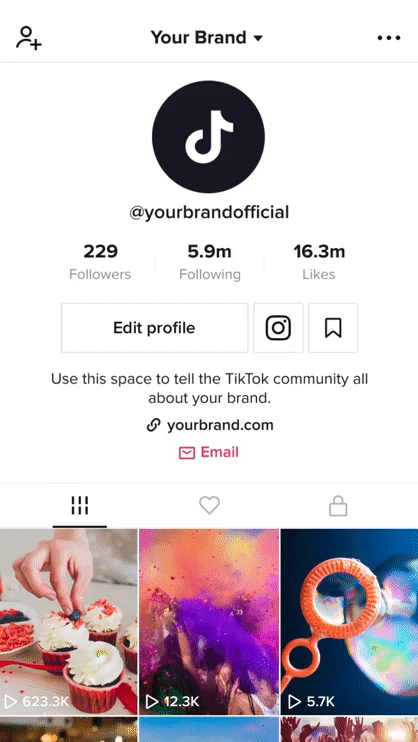
Still not sure which platforms are the right fit for your business? The best way to find out where your customers spend time online is to ask them. Try sending out a survey and asking the following questions:
- Which social platforms do you hang out on the most?
- For what purpose do you use these platforms?
- How much time, on average, do you use these platforms each day?
- Have you ever purchased a product or service after clicking on a Facebook or Instagram ad?
Set clear goals
The next step is to establish and set clear social media goals. What do you want to achieve out of your social media marketing efforts? Are you trying to position yourself as an industry expert? Or maybe you want to use your social media channels as a way to increase traffic to your website.
Whatever it is that you want to achieve out of your social media efforts, we suggest writing those goals down. This will allow you to not only keep a track of your goals but also help you make sure you’re on track to achieve them.
But setting goals can sometimes be more easily said than done—you have to make sure you’re setting the right kind of goals. Establishing goals like “I want to increase my Instagram followers” won’t give you and your team a clear understanding of what you want to achieve.
And that’s where SMART goals come in.
Setting SMART goals is a results-driven goal-setting method that has helped numerous businesses achieve groundbreaking results.
But what, exactly, are SMART goals?
Allow us to explain. SMART stands for:
- Specific
- Measurable
- Attainable
- Relevant
- Time-based
Your goals should fit the above criteria—here’s an example:
“I want to increase my Instagram follower count from 2,000 to 3,000 in a month.”
This goal will give you and your team a clear understanding of what needs to be achieved and by when. Now, you can break down this goal into SMART objectives, allowing you and your team to build a fool-proof actionable game plan to achieve them.
Measure success & adjust your marketing strategy
Once you have established your goals and are aware of the platforms that you need to focus your efforts on, it’s time to start working your magic.
From publishing high-quality content pieces that deliver value to your local audience to interacting with them on a regular basis, you’ll have a lot on your plate. It might feel overwhelming at first, but our best tip is to be consistent with your social media efforts. And at the end of every month, make sure to review your performance by diving deep into relevant metrics.
Measuring your success on a consistent basis will help you keep a clear understanding of what’s working and what’s not. If a platform isn’t working for you, don’t be afraid to pivot. As you measure your success and make small adjustments along the way, you’ll be amazed by the results.
Social Media Marketing FAQ: What You Need to Know
1. What is the fastest-growing social media platform 2022?
And the crown goes to…TikTok. Shortform videos continue to be a crowd-pleaser and are making it possible for almost anyone with a camera to participate. As such, it can feel a bit like the wild west for small businesses. As we stated before, building a stronger strategy around the platform is incredibly important to sustained success.
2. Should I use TikTok?
That depends on your audience! Is your audience frequenting TikTok? Then you better get on there. In all seriousness, your decision should ultimately be made based on:
- If your audience is frequenting the platform
- If you have the time to dedicate to posting consistently and responding consistently
3. What are the best tools to use for social media marketing?
There are a lot of really great tools out there. While Podium can help you build a great online reputation via Google reviews, social media management platforms like the following can help you manage the day-to-day scheduling and responding:
Start Building Your Brand with Social Media
Social media marketing is a powerful local online marketing strategy that’ll allow you to not only build long-lasting relationships with people in your local community but also increase your revenue. And if you haven’t already been focusing on promoting your business across different platforms, starting with Facebook, Twitter, or Instagram can be a great first step.
Don’t wait around—tap into the power of social media today.







